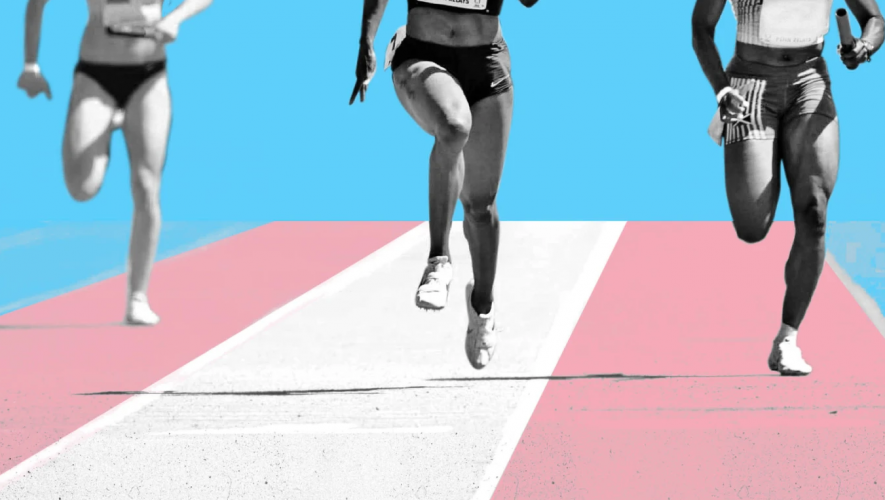On his first day in office, President Joe Biden signed an executive order combatting discrimination based on gender identity or sexual orientation. The order allowed trans children to access restrooms, locker rooms, and school sports of their gender identity and directed the Attorney General to evaluate states’s current regulations.
In retaliation, almost thirty deep-red states introduced bills restricting or banning trans female athletes’s participation in women’s sports.
However, no matter biology’s implications for athletes’s performance, bans are not the proper way to address participation in sports. Bans are a black-and-white response to a social issue with a spectrum of solutions, and they leave no room for nuance.
Bans are unnecessary and harmful
Contrary to popular belief, biological sex doesn’t necessarily determine sports performance.
Dr. Joshua Safer is an endocrinologist, expert in transgender biology, and the president of the United States Professional Association for Transgender Health—a worldwide nonprofit with over 3,000 members. He argues that multiple biological characteristics contribute to a person’s sex, and “they may not all align as typically male or female in a given person.” People who are cisgender can have hormone levels that vary, so genetic make-up and reproductive anatomy are not indicative of a person’s athletic performance.
Trans female athletes echo this sentiment. Idaho’s ban last year impacted Lindsay Hecox, a transgender runner at Boise State University. Though Hecox had already begun transitioning, the ban barred her from running competitively. She attributed the law to misconceptions about trans women’s athletic abilities.
“It’s something about trans women athletes. They feel like it’s going to be some huge, tall, muscular superstar,” Hecox said. “I don’t even think most of my teammates would even think of me as trans—I just look like a regular girl.”
Even contradictory research—which does find biological differences such as strength, muscle mass, and higher levels of endurance-impacting hemoglobin between men and women—doesn’t imply that bans are necessary for sports. Biological differences are present between all athletes, not just trans and cisgender ones. It is not a question of men competing with women; trans women are women, and there is no justification for outright excluding them.
Joanna Harper, a leading trans sports researcher in the United Kingdom, acknowledges that as a population group, trans women have athletic advantages over cisgender women but argues, “we do, however, allow for advantages in sports.”
For example, the average height of a professional basketball player in the NBA is 6’6”. Yao Ming, a former player for the Houston Rockets, was 7’6”. Being a full foot taller than his average competitor, he had a considerable advantage over other players. Likewise, left-handed pitchers are advantaged in baseball because the angle of their throws is rarer and harder to hit. Yet, neither of these scenarios has prompted bans of ultra-tall basketball players or left-handed pitchers.
Athletic abilities vary regardless of the gender doctors assign someone at birth. Trying to compensate for all differences an athlete may have is not feasible. Unless organizations are looking to ban all natural advantages, trans bans are discriminatory.
Regulations are more effective and inclusive
Pro-ban advocates may respond to all of this by claiming that the biological differences between cisgender and trans athletes are more extreme than typical biological differences. Still, transition regulations are a more inclusive strategy for overcoming trans-cis performance differences than outright bans.
Organizations such as the National Collegiate Athletic Association (NCAA) and the International Olympic Committee (IOC) acknowledge biological differences between trans and cis athletes and demand stipulations as a result. The NCAA requires testosterone suppression treatment of at least a year before transgender women can compete in women’s sports, and the IOC adds that the athlete must have declared their gender identity for a minimum of four years.
The 2020 Tokyo Olympic games provided the first opportunity to see such regulations in action when New Zealand weightlifter Laurel Hubbard competed as the first openly transgender athlete in a gender category different than the one assigned to her at birth. As her gender identity changed from male to female, many worried that she had an unfair advantage, especially given that she previously competed at the national level as a man.
Nevertheless, Hubbard’s transgender identity did not seem to guarantee her a win, and worries about her potential advantages were unfounded. She competed in only one event—the over-87-kilogram division—and left without a medal. In fact, of the thirteen finalists in the division, she was the only one who didn’t complete at least one successful lift.
Roger Pielke Jr., a professor of sports governance at the University of Colorado Boulder, acknowledged that while the IOC should review their policies, “a ban seems socially and politically untenable.”
The answer is never a ban
For some cisgender female athletes, banning transgender female athletes feels essential to their ability to compete. Madison Kenyon, a sophomore runner at Idaho State University, spoke out in favor of the bans after a trans female athlete beat her.
Some ban-supporters argue that trans women’s participation in sports undermines biological women’s equality under Title IX. The Alliance Defending Freedom—a conservative public interest law nonprofit—filed a lawsuit in Connecticut on behalf of three high school track athletes who felt that competing against transgender athletes caused them to lose out on state titles and potential scholarships. One of the plaintiffs, Chelsea Mitchell became an advocate for bans after losing several state track titles in high school and finishing in third place behind two transgender girls in 2019.
While it is true that transgender athletes may win a competition, the same can also be said for cisgender athletes. Mitchell beat one of the trans runners in a later race and was awarded a scholarship to Virginia’s College of William and Mary, while neither of the two trans competitors that once beat her was offered scholarships.
At higher levels, hormone treatments are one way to address these concerns without outright banning participation. Hecox, the transgender runner from Idaho, began hormone replacement therapy to meet the NCAA requirements. She said that the treatment decreased her muscle mass and stamina, bringing her athletic abilities closer to the range of other female athletes.
“I could feel myself getting slower,” she said, “and I was all right with that.”
However, while puberty blockers are generally considered safe for younger children, other treatments after puberty, like certain kinds of hormone therapy, carry medical risks for people under the age of eighteen.
Unless athletes younger than eighteen are comfortable taking puberty blockers, the answer lies in simply doing nothing. As Dr. Safer points out, “testosterone provides less of an impact for a 14-, 15- or 16-year-old,” so biological advantages are few and far between.
A recent study from the Women’s Sports Foundation and the National Center for Lesbian Rights recommends letting transgender girls compete in sports as soon as they begin their social transition—that is, dressing and acting in accordance with their gender identity. The authors note that requiring hormone therapy is “unfair and too complicated” at the high school level but suggest schools keep athletes up to date on college rules since it could impact their participation at a higher level.
The real issue to consider is not whether trans women should be allowed to compete with cisgender women. That would be like asking whether Black and white women should compete together. Trans women are women, and banning them from competing with their true gender invalidates that identity. Instead, the important questions to ask are: How can transgender and cisgender athletes come together in meaningful competition, and how can we address the current state of athletics to allow for equal opportunities on both sides?
There is still research to be done, but exclusion is not a solution. Trans female athletes should be allowed to compete in their desired gender category, and it is up to lawmakers to search for a way to include them. No matter the perspective taken on the issue, outright banning trans female athletes is an extreme measure—and an unnecessary one.



